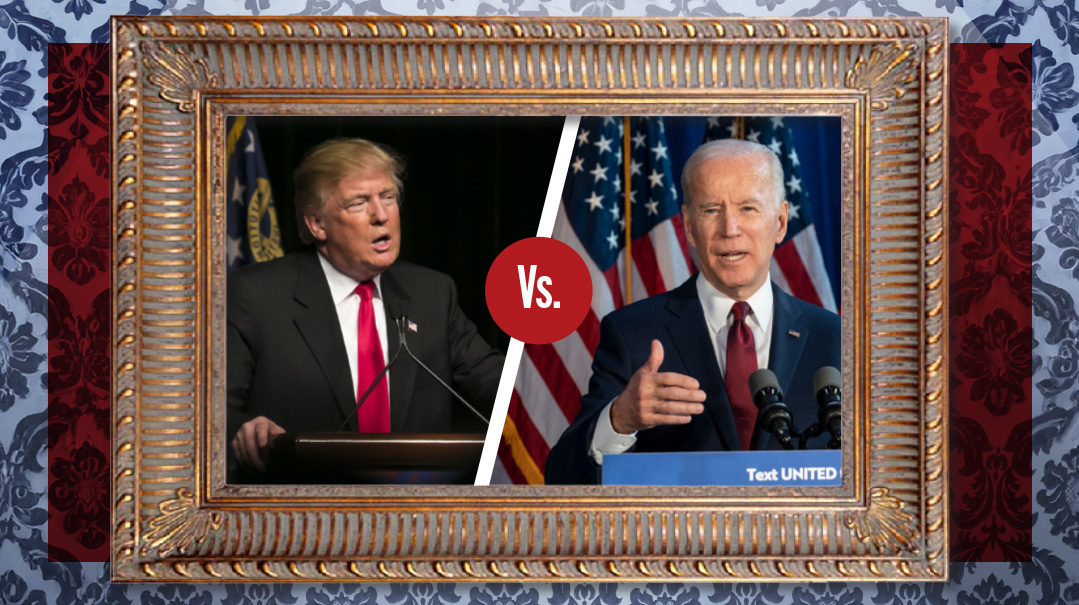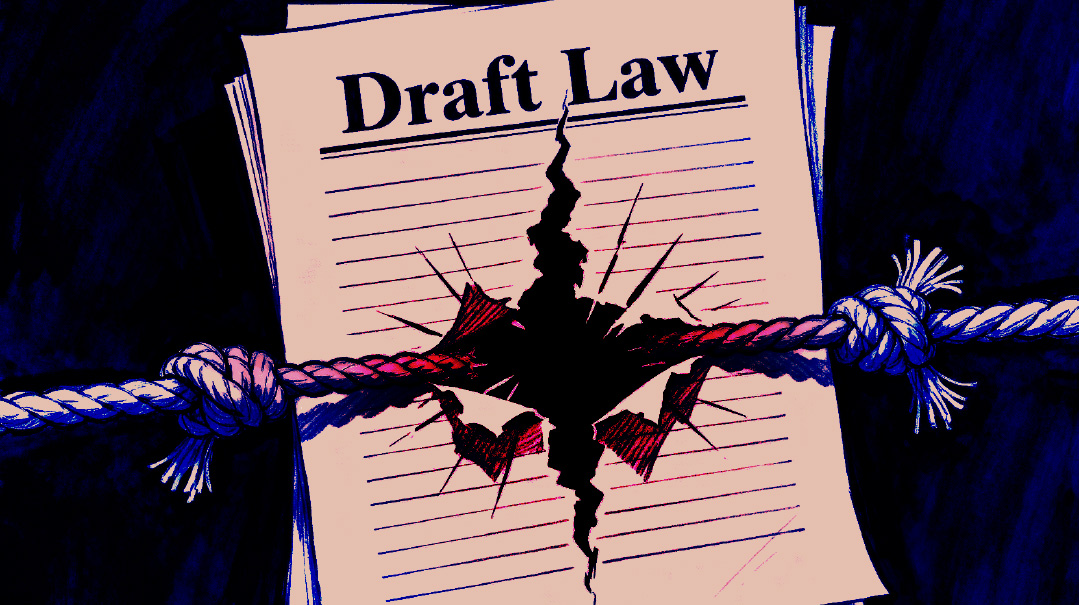Round Two
| March 12, 2024The looming rematch between President Joe Biden and former president Donald Trump in the context of all the other such contests

Photos: AP Images, Shutterstock
Presidential historian and former senior Bush administration official Tevi Troy frames the looming general election rematch between President Joe Biden and former president Donald Trump in the context of all the other such contests that have been fought out over the last 180 years
The rematch election shaping up in 2024 between President Biden and the man he defeated, former president Trump, is unprecedented during the lifetimes of Mishpacha’s younger readers. But American history offers several prior examples of this kind of contest.
Before this year, the last defeated president to consider taking on the man who beat him was Gerald Ford. He ultimately decided not to challenge Jimmy Carter in 1980. He did, however, flirt with the idea of running as Ronald Reagan’s vice presidential candidate, although that also did not pan out.
This kind of rematch was more common in the 19th century than in the 20th, and Trump versus Biden will be our first rematch of the 21st century. The most recent two rematches, William McKinley versus William Jennings Bryan (1896 and 1900) and Adlai Stevenson versus Dwight Eisenhower (1952 and 1956), resulted in sweeps, with the Republican candidate winning both elections each time.
These two sweeps are why parties are often reluctant to nominate the losing candidate again. Since the late 20th century, the American ethic has been “once a loser, always a loser”: think Walter Mondale in 1984 or Michael Dukakis in 1988. But the 19th century was more forgiving, and the four rematches that took place before the 20th century led to the first-time loser becoming a winner the second time, which is a more positive sign for Mr. Trump than the more recent history suggests.
Here is a review of presidential rematches, with some lessons we can learn from them.
1. John Adams versus Thomas Jefferson (split)
Lesson learned: Beware the vice president
John Adams was George Washington’s vice president. Thomas Jefferson was Washington’s secretary of state. Washington feared the development of factions, but this matchup of two veterans of his administration revealed the partisan, faction-ridden direction in which the country was headed in 1796.
As Washington’s vice president, Adams was the favorite, but he was also irascible, thin-skinned, and often accused of having monarchist tendencies. Adams won an extremely close election, 71 electoral votes to 68, but because the Constitution then called for the runner-up in the presidential election to become vice president, Jefferson ended up as Adams’s vice president.
As one could imagine, Jefferson was not the most cooperative vice president, and ran against Adams in the next election, in 1800. This was a bitter campaign filled with lots of invective, and this time Jefferson prevailed, but he was himself subjected to a constitutional anomaly: The vice presidential candidate was now part of a slate with the presidential candidate, but received his own electoral votes independently.
To avoid the divided outcome of the 1796 election, the two parties had each planned to make sure their vice presidential candidates got exactly one fewer electoral vote than their presidential candidates, to ensure the man at the top of the ticket would win. But in the course of the bitter campaign, with internal battles dividing Jefferson’s Democratic-Republican party, the plan fell by the wayside.
Jefferson’s vice presidential pick was Aaron Burr, and they received an identical number of electoral votes. That tie sent the deadlocked election to the House of Representatives, with Burr now vying against his ticket-mate Jefferson for the presidency. Burr failed, but made an enemy for life in Jefferson.
That controversy also set up the famous duel between Burr and Alexander Hamilton, whose crucial support for Jefferson allowed him to become president, angering Burr. At the end of the process, Adams, to his credit, left office and went back to Boston, making this the first peaceful democratic transfer of power in modern history.
2. John Quincy Adams versus Andrew Jackson (split)
Lesson learned: An aggrieved loser is a dangerous opponent
John Quincy Adams versus Andrew Jackson in 1828 was the second rematch. Quincy Adams was the son of John Adams, founding father and loser of the first rematch. Quincy Adams may have been the best prepared person ever to be president. He was a senator, served as minister to four countries, and was secretary of state. He was well educated and widely read; he would translate texts from Greek or Latin to English for fun. He had wanted to be a scholar but instead joined the family business of politics.
While Quincy Adams was a great candidate on paper, he lacked popular appeal. This proved to be a problem in running against Andrew Jackson, a populist politician from Tennessee. Jackson did not have any of the educational achievements of Quincy Adams — he could barely spell — but he knew how to reach the people. Jackson won a plurality of the vote in the 1824 election but not a majority, sending the election to the House of Representatives, where Henry Clay directed his support to Quincy Adams. Clay ended up as secretary of state in the Quincy Adams administration, leading Jackson to claim that he was robbed, denouncing the “corrupt bargain” that gave Quincy Adams the presidency and Clay the secretary of state position.
Like Trump, Jackson remained a favorite to his fans even in defeat. President Quincy Adams went to the theater one night and found the audience cheering for Jackson, upsetting Quincy Adams — he didn’t return to the theater for two years afterwards — but also indicating the degree to which he trailed in popular sentiment. Jackson ran again against Quincy Adams in 1828. This time the election was not nearly as close, and Jackson won a clear majority of both the popular and electoral vote.
As president, Jackson went to Harvard — Quincy Adams’s alma mater — to receive an honorary degree. Quincy Adams protested this decision, but to no avail. When getting his degree, Jackson refused to accept his prize in Latin, which was the norm at the time. He said he couldn’t converse in Latin, as all he knew in that language was “E Pluribus Unum.” Even at Harvard, Jackson knew how to appeal to the common man.
3. Martin Van Buren versus William Henry Harrison (split)
Lesson learned: Nicknames can be powerful
Jackson served two terms as president, and his popularity helped secure the presidency for his vice president, Martin Van Buren, who didn’t have the same appeal. He’s the only president for whom English was his second language; he spoke Dutch growing up in his upstate New York childhood home. But Jackson’s coattails were sufficient to help Van Buren defeat Ohio politician and war hero William Henry Harrison in 1836.
In 1840, Harrison, known as “Old Tippecanoe” for a battle he won in 1811, took another crack at Van Buren. This time, he ran with John Tyler, using the catchy slogan, “Tippecanoe and Tyler Too.” Van Buren also now had his own record to defend, including the 1837 recession that led to him being dubbed “Van Ruin.” Furthermore, Andrew Jackson had receded further into the background, making it harder for Van Buren to capitalize on his former running mate’s popularity.
This time, Harrison beat Van Buren in an election that was somewhat close in the popular vote, but not so in the electoral vote. Unfortunately for Harrison, he didn’t get much time to enjoy his prize. He died 31 days after being sworn in, serving the shortest tenure in presidential history.
4. Grover Cleveland versus Benjamin Harrison (split)
Lesson learned: You can go home again
It would be a half century before America had another rematch. While the first two rematches involved the father-son combination of John Adams and John Quincy Adams, this rematch had Benjamin Harrison, grandson of short-lived President William Henry Harrison, going up twice against the conservative New York Democrat Grover Cleveland.
While this was a period of Republican dominance in presidential elections, Cleveland had culminated a meteoric rise in American politics by winning the presidency in 1884. As president, Cleveland was a strict constitutionalist and opponent of economic intervention, which is why he’s largely uncelebrated by the Democratic Party today.
In 1888, the Civil War hero and Republican Indiana politician Harrison challenged Cleveland. In a close election, Cleveland won the popular vote but lost the electoral vote and had to leave the White House, showing that this controversy has a long history. Upon exiting, Cleveland’s wife Frances told the staff to watch over the furniture, promising, “We are coming back just four years from today.”
Frances was prophetic. Cleveland ran again in 1892 and won, making him the first person to win the popular vote for president three times in a lifetime. Cleveland returned to the White House, but found that second terms, even nonconsecutive ones, are challenging. His second term included the Panic of 1893 recession and painful — and secret — oral surgery to remove a tumor, leaving him somewhat weakened and diminished.
5. William McKinley versus William Jennings Bryan (sweep)
Lesson learned: Don’t take on a popular president, even if no one else wants to
The next rematch was not long in coming. In 1896, free silver advocate William Jennings Bryan electrified the Democratic convention with his “Cross of Gold” speech, one of the most famous convention speeches in history. Bryan was a powerful orator, and the crowd erupted after he finished, which helped elevate him to the nomination.
While the 36-year-old Bryan was the youngest nominee in presidential history to receive an electoral vote, he had the misfortune of running against William McKinley, the talented and politically savvy Ohio Republican governor. McKinley defeated the populist Bryan — who ran on both the Democratic and Populist tickets — to win the presidency.
McKinley remained popular as president, and when 1900 came around, few Democrats were interested in testing him. That left the field open for Bryan to try his hand again, which he did, once again unsuccessfully, losing by a bigger margin the second time around.
Things did not work out that well for McKinley, either, as he was assassinated early in his term, bringing the young reformer Teddy Roosevelt into the White House. As for Bryan, he would run for president again in 1908, this time losing to Roosevelt’s hand-picked successor, William Howard Taft.
Bryan’s third loss contributed to the 20th century perception that losers continue to lose. Bryan finally made it to the executive branch in 1913, serving as secretary of state to Woodrow Wilson.
6. Dwight Eisenhower versus Adlai Stevenson (sweep)
Lesson learned: The “thinking man” does not necessarily win
In 1952, Dwight “Ike” Eisenhower was a war hero whom both parties wanted as their standard bearer. This indicated his high popularity level and made beating him in the 1952 election an uphill battle. When Ike chose the GOP, Democratic Illinois governor Adlai Stevenson ran against him and became a favorite of the intellectuals in the process.
At one event, someone in the crowd shouted, “Every thinking man will be voting for you.”
Stevenson memorably responded, “I’m afraid that won’t do. I need a majority.”
It’s funny that the smart set gravitated so heavily to Stevenson, since his own intellectual bona fides were lacking. He did go to Princeton, and projected a sophisticated air, but he was not much of a reader — the social register was the book most likely to be found on his nightstand. Ike was actually more of a reader. He underwent the equivalent of a graduate education under the tutelage of General Fox Connor, a book-loving superior of Eisenhower’s who recommended many titles for him to read.
Eisenhower was a successful and popular president, but Stevenson nevertheless tried again in 1956. He didn’t do much better, garnering even fewer electoral votes the second time. He did have an interesting nominating convention, though; a young senator named John F. Kennedy lobbied to become Stevenson’s vice-presidential nominee. Kennedy failed, and Tennessee’s Senator Estes Kefauver got the nod. But Kennedy would be the successful Democratic standard bearer in 1960, defeating Eisenhower’s vice president, Richard Nixon.
As for Stevenson, who ran for the Democratic nomination again in 1960, this time failing, he went on to become Kennedy’s ambassador to the United Nations.
7. Donald Trump versus Joe Biden (?)
Lesson: To be determined...
In 2016, real estate developer and entertainer Donald Trump shocked the world by defeating former first lady, New York senator, and Secretary of State Hillary Clinton to become president. Trump had a particular talent for infuriating Democrats, and in 2020 they were determined to beat him.
Longtime Delaware senator and former vice president Joe Biden lost the first two nominating contests. But with Democrats panicked at the prospect of the socialist Bernie Sanders winning the nomination and potentially losing to Trump, the party threw its support behind Biden, who dominated the rest of the primaries going forward.
Biden beat Trump in a closely contested election, which left Trump complaining about — and agitating against — what he saw as an unfair result. Trump declared early on his willingness to try again, and easily defeated all comers in the 2024 Republican primaries.
Meanwhile, Biden looks increasingly old as president, even though he is not much older than Trump. Despite Trump’s easy path to the nomination, he still faces many legal hurdles, in terms of a series of criminal and civil cases against him in multiple jurisdictions.
The next eight months will determine if Trump joins 19th century “rematchers,” who won after losing their first contest; or if, in the vein of the 20th century “rematchers,” he loses a second consecutive election.
Presidential historian Tevi Troy is a senior fellow at the Bipartisan Policy Center, a senior scholar at Yeshiva University’s Straus Center, and a former White House aide. He is the author of five books on the presidency, including the forthcoming The Power and the Money: The Epic Clashes between American Titans of Industry and Commanders in Chief, which will hit bookshelves in August.
(Originally featured in Mishpacha, Issue 1003)
Oops! We could not locate your form.







